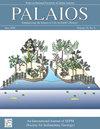TAPHONOMIC INDICATORS OF DEAD OCEAN QUAHOG (ARCTICA ISLANDICA) SHELL AGE IN THE DEATH ASSEMBLAGE OF THE MID-ATLANTIC BIGHT CONTINENTAL SHELF
IF 1.5
4区 地球科学
Q2 GEOLOGY
引用次数: 0
Abstract
Abstract: Taphonomic indicators are often used to assess time-since-death of skeletal remains. These indicators frequently have limited accuracy, resulting in the reliance of other methodologies to age remains. Arctica islandica, commonly known as the ocean quahog, is a relatively widespread bivalve in the North Atlantic, with an extended lifespan that often exceeds two hundred years; hence, their shells are often studied to evaluate climate change over time. This report evaluates taphonomic age using 117 A. islandica shells collected from the Mid-Atlantic Bight offshore of the Delmarva Peninsula with radiocarbon dates extending from 60–4,400 cal years BP. These shells had varying degrees of taphonomic alteration produced by discoloration and degradation of periostracum. To determine if a relationship exists between taphonomic condition and time-since-death, radiocarbon ages were compared with the amount of remaining periostracum and type of discoloration. Old shells (individuals that died long ago) were discolored orange with no periostracum while younger shells (individuals that died more recently) had their original color, with some periostracum. Both the disappearance of periostracum and appearance of discoloration followed a logistic process, with 50% of shells devoid of periostracum and 50% discolored in about 1,000 years. The logistic form of long-term taphonomic processes degrading shell condition is first reported here, as are the longest time series for taphonomic processes in death assemblages within the Holocene record. This relationship can be utilized for triage when deciding what shells to age from time-averaged assemblages, permitting more efficient application of expensive methods of aging such as radiocarbon dating.中大西洋暗大陆架死亡组合中死洋圆蛤(北极岛屿)壳年龄的地理指示
摘要:Taphonomic指标通常用于评估骨骼遗骸死亡后的时间。这些指标往往准确性有限,导致依赖其他方法来确定遗体的年龄。Arctica islandica,通常被称为海洋quahog,是北大西洋一种分布相对广泛的双壳类动物,其寿命通常超过200年;因此,人们经常研究它们的外壳来评估一段时间内的气候变化。本报告使用从德尔玛瓦半岛大西洋中部湾近海收集的117枚A.islandica贝壳评估了地震学年龄,放射性碳年代为英国石油公司60-4400卡年。这些外壳有不同程度的由介形虫的变色和降解引起的深部形态改变。为了确定埋葬状况和死亡时间之间是否存在关系,将放射性碳年龄与残留的介形虫数量和变色类型进行了比较。旧的外壳(很久以前死亡的个体)是橙色的,没有周介壳,而年轻的外壳(最近死亡的物种)则是原来的颜色,有一些周介壳。周介壳的消失和变色都遵循一个逻辑过程,在大约1000年的时间里,50%的外壳没有周介壳,50%的壳变色。这里首次报道了长期埋藏过程降解外壳条件的逻辑形式,以及全新世记录中死亡组合中埋藏过程的最长时间序列。当决定从时间平均组合中老化什么贝壳时,可以利用这种关系进行分类,从而更有效地应用昂贵的老化方法,如放射性碳年代测定。
本文章由计算机程序翻译,如有差异,请以英文原文为准。
求助全文
约1分钟内获得全文
求助全文
来源期刊

Palaios
地学-地质学
CiteScore
2.80
自引率
12.50%
发文量
40
审稿时长
6 months
期刊介绍:
PALAIOS is a monthly journal, founded in 1986, dedicated to emphasizing the impact of life on Earth''s history as recorded in the paleontological and sedimentological records. PALAIOS disseminates information to an international spectrum of geologists and biologists interested in a broad range of topics, including, but not limited to, biogeochemistry, ichnology, paleoclimatology, paleoecology, paleoceanography, sedimentology, stratigraphy, geomicrobiology, paleobiogeochemistry, and astrobiology.
PALAIOS publishes original papers that emphasize using paleontology to answer important geological and biological questions that further our understanding of Earth history. Accordingly, manuscripts whose subject matter and conclusions have broader geologic implications are much more likely to be selected for publication. Given that the purpose of PALAIOS is to generate enthusiasm for paleontology among a broad spectrum of readers, the editors request the following: titles that generate immediate interest; abstracts that emphasize important conclusions; illustrations of professional caliber used in place of words; and lively, yet scholarly, text.
 求助内容:
求助内容: 应助结果提醒方式:
应助结果提醒方式:


